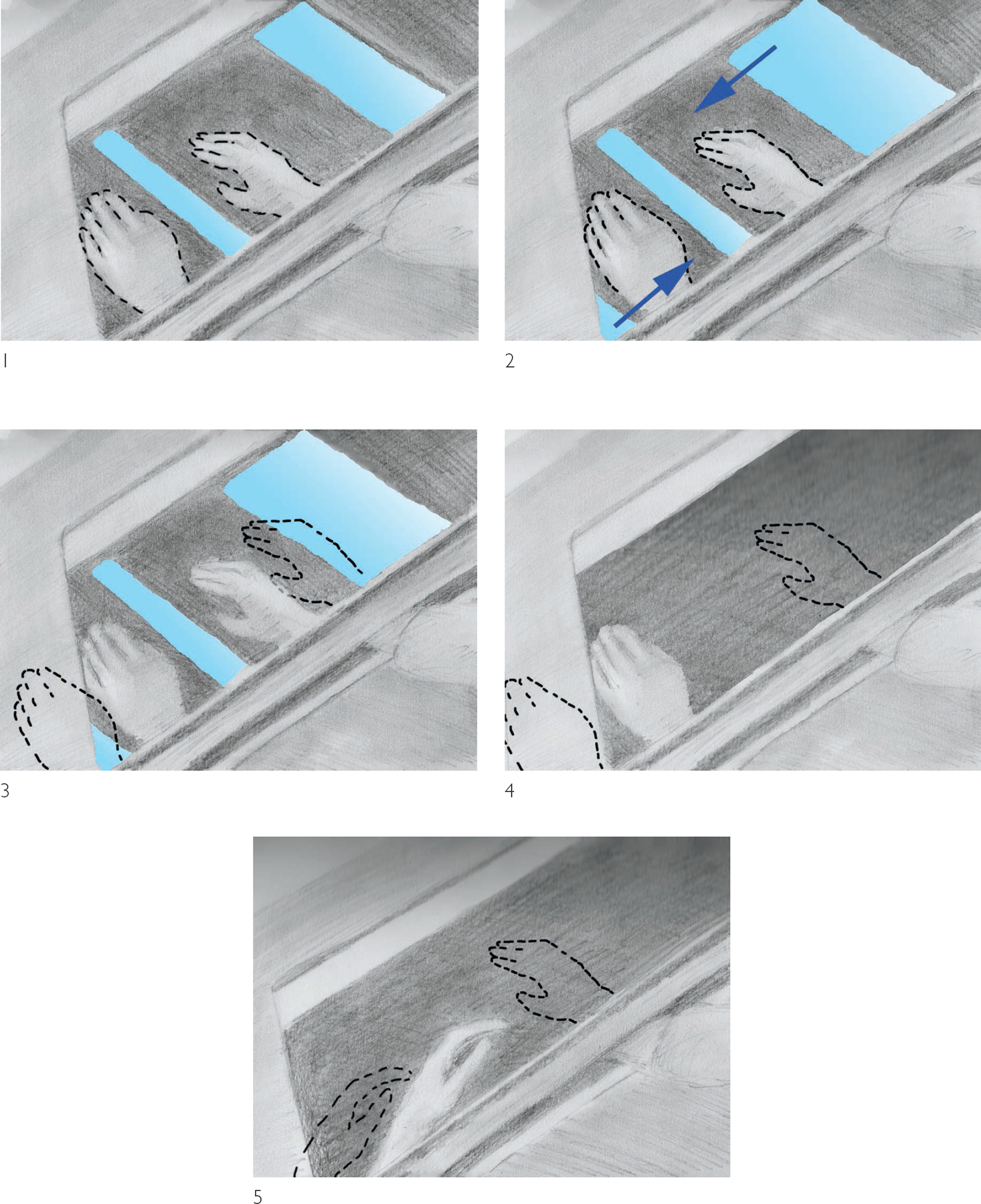
MULTISENSORY AND NONVISUAL ILLUSIONS
Our nervous system gathers all different kinds of sensory information from the outside world and from our own bodies, but visual inputs take up the most processing power. Though the experience of viewing an object may seem simple and effortless, our brain’s cortex alone dedicates more than two dozen areas to analyzing, filling in, transforming, and relaying visual inputs. Such extraordinary allocation of neural muscle can make us lose sight—pun intended—of the fact that our experience of the world is fundamentally multisensory. Scientists and philosophers since Aristotle have pondered how the brain is able to integrate different kinds of sensory information into a unified perception. In the initial stages of neural processing, the inputs from the different senses (sight, touch, hearing, taste, and smell) are kept separate, in different processing streams that lead to different cortical areas of the brain (the visual cortex, the somatosensory cortex, the auditory cortex, and others). These areas are physically distinct and largely disconnected from one another. Even within a given sensory modality, such as in the visual system, specific cortical areas and populations of neurons deal with particular features, such as motion, color, texture, and faces. How the brain puts together different kinds of information so that when we encounter a puppy we can see it wagging its tail, feel its fur under our hands as we pet it, and hear its excited bark all at once, as a single perception, is a neuroscientific mystery known as “the binding problem.” Some of the illusions in this chapter illustrate the paradoxical features of our nonvisual perception. Others demonstrate the unusual ways in which our brain integrates (or sometimes fails to integrate) the information arriving from our different senses.
BY ROGER NEWPORT, HELEN GILPIN, AND CATHERINE PRESTON
UNIVERSITY OF NOTTINGHAM, U.K.
2012 FIRST PRIZE

A trusting young woman puts her hands in a box with a transparent top. She is participating in a science experiment, but this one has the aura of a magic show. The researchers ask her to hold her hands steady between two vertical blue lines. She does so, watching her hands carefully. They do not appear to move, nor does she feel as if they are moving. The investigators flick a switch and the right side of the box darkens, obscuring her right hand. They ask her to reach across with her left hand and touch her now invisible right one. She complies—but her eyes widen with alarm. All she feels is empty space. “Where’s my hand gone?” she asks anxiously. Then, suddenly, she explodes with laughter. Still, just to be sure, she pulls both her hands from the box to check that they are still there—they are.
This scene, captured on video, helped the inventors of the mirage multisensory illusion box win first prize at the 2012 Best Illusion of the Year Contest. Like many illusions, this one was discovered by accident. Three psychologists created the box to study how the brain integrates visual input, tactile information, and proprioception, or bodily sensations that tell us about the position of our limbs in space. One day, Roger Newport, one of the psychologists, was trying to fix a misalignment in the box. He discovered that his right hand was in the wrong place and his left one was out of sight. “I tried to touch my left hand with my right and missed it. I was so surprised I decided to see whether I could re-create the feeling experimentally,” he says. Equipped with a camera, a mirror, and a monitor, the box created the illusion that the woman was looking at her own hands when in fact she was seeing a video re-creation of them. The hand images, manipulated by computer software, moved slowly inward. To compensate, the woman moved her hands outward—although it all happened so gradually that she did not notice. In less than a minute, the space between her hands became much greater than she realized. Then she was surprised when she tried to touch her hand and discovered that it was not where she thought it was.
In everyday experience, sensations such as sight, touch, and proprioception work together to inform us about the location of our various body parts. Think of how jerky a baby’s early movements are, and how unsteady she is as she learns to walk. She dynamically adjusts and re-adjusts virtually every muscle in her body as she struggles to remain upright. You do the same, even when sitting still, just more smoothly and without conscious oversight. The mirage box created by Newport and his colleagues shows that the brain is easily confused when our touch and bodily sensations are dissociated from the visual input. For a demonstration, visit the Best Illusion of the Year Contest website. An amusing video showing the best reactions from participants in the Disappearing Hand Trick is available on YouTube.

BY PETER TSE
DARTMOUTH COLLEGE, U.S.A.
2013 FINALIST
Illusions are not only perceived by our visual system. They can also be created through the sense of touch, as noticed by the cognitive neuroscientist Peter Tse of Dartmouth College. Try it yourself. Get a pencil and a small, round, hard sphere, such as a ball bearing or a marble. First, squeeze the sides of the pencil very tightly between your thumb and forefinger for sixty seconds or so, until you make deep indentations in your thumb and forefinger pads. Now feel the ball bearing at the location of the indentations by rolling it around. The ball no longer seems round but instead feels as if it has rounded corners—as if the ball were hexagonal in cross section, just like the pencil. When you squeeze the pencil, the array of touch receptors in your skin takes on its shape. Your brain assumes that the skin where your receptors are located is smooth and round, and it misattributes these perceived edges as belonging to the ball.

BY MASASHI NAKATANI
KEIO UNIVERSITY, JAPAN
2011 FINALIST
This tactile illusion will give you a very fishy feeling. At the 2011 Best Illusion of the Year Contest, the scientist Masashi Nakatani, who studies haptic perception (i.e., the sense of touch), showed up dressed in spearfishing attire and passed out business cards embossed with the shape of a stylized fish. With the flourish of a magician, Nakatani approached the emcee, the vision scientist Peter Thompson, onstage and told him, “Rub your finger up and down the spine. Up and down the spine. You feel a groove there? But … there … is … none!” Thompson rubbed the fish’s spine as instructed. “How do you feel?” Nakatani asked.
“I feel dirty for feeling up this fish,” Thompson deadpanned. “But I do feel a groove here.”
Nakatani was intrigued by the possibility that the brain might experience tactile as well as visual illusions. He thought he could create a texture that was not a circle but would feel like one. The fishbone pattern (without a head or tail) was one of many botched attempts. Disappointed, Nakatani took the sample to a senior colleague, Susumu Tachi, and described his failure. Tachi agreed that the texture did not feel like a circle, but he noticed a central groove where there was none. He encouraged Nakatani to change his dissertation project to study the fishbone illusion full-time. By testing a variety of configurations and textures, Nakatani and his colleagues determined that the illusion arises from how tactile receptors in your skin compare smooth and rough textures. Even though the spine and ribs of the fish are embossed exactly the same way, the ribs feel rougher to the touch because they are discontinuous; the spine is continuous from beginning to end, so it feels smoother than the ribs. Your brain interprets the smooth spine to be lower than the rough ribs of the fish—and you’re hooked.
DISAPPEARING SMOKE— DISAPPEARING PLEASURE!
BY SIDNEY PRATT, MARTHA SANCHEZ, AND KARLA ROVIRA
SIN HUMO, COSTA RICA
2013 FINALIST
The clinical psychologists Sidney Pratt, Martha Sanchez, and Karla Rovira are members of Sin Humo, an anti-smoking treatment program in Costa Rica whose name translates to “Without Smoke.” Their illusion was inspired by a relaxation technique in which a person closes his or her eyes while smoking. This small act, surprisingly, decreases the enjoyment typically felt from a cigarette—and less enjoyment, they reasoned, would lead to weaker addiction.
Pratt’s team wondered, was it relaxation per se that reduced the patients’ gratification? Or was it primarily the fact that the patients’ eyes were closed, preventing them from seeing the burning cigarette? To find out, they simply asked the patients to smoke while blindfolded, and learned that the blindfold did in fact account for the reduction in the pleasure from smoking.
The contest judges classified this demonstration as an illusion because the smokers’ perceptions did not match the biochemical reality of smoking. In other words, we assume that the amount of pleasure derived from a cigarette should be based on the amount of nicotine it delivers. That amount, of course, is the same with or without the blindfold, and so the patients’ brains were effectively tricked.
In light of these findings, the researchers reasoned that seeing the smoke from a cigarette might strengthen nicotine addiction because the smoke is associated with past experiences of feeling satisfied. Their discovery also suggests that it’s very rare for any experience to affect a single sensory modality. All of our senses may be engaged in powerful, unexpected ways when we interact with the world around us. The blindfolding technique is now the cornerstone of the team’s anti-smoking treatment plan.